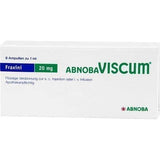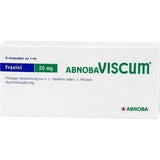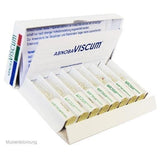Abnoba viscum fraxini, ABNOBAVISCUM Fraxini 0.2 mg ampoules
Active ingredients
- 0.01 ml ash mistletoe extract (1:50); Extract agents: sodium monohydrogen phosphate dihydrate, ascorbic acid, water for injection purposes
Abnoba viscum fraxini Auxiliary materials
- Disodium hydrogen phosphate-2-water
- Ascorbic acid
- Water for injections
Abnoba viscum fraxini Active ingredient:
Each ampoule contains 0.01 ml extract from fresh ash mistletoe
WHAT ABNOBA VISCUM IS AND WHAT IT IS USED FOR?
ABNOBAVISCUM is an anthroposophic medicine for the extended treatment of tumor diseases.
Abnoba viscum fraxini Areas of application:
According to the anthroposophical knowledge of man and nature, the abbob-VISCUM is used to stimulate the form and integration forces of adults to dissolve and reintegrate independent growth processes, e.g.
- in malignant tumor diseases, also with accompanying disorders of the blood-forming organs
- in benign tumor diseases
- to prevent relapses (recurrence prophylaxis) after tumor operations
- in the preliminary stages of certain cancers (defined precancerous diseases).
How should abnoba ViSCUM be used?
Type of application:
If possible, the subcutaneous injection should be carried out near the tumor or metastasis, otherwise in constantly changing parts of the body (different places in the abdomen, possibly the thigh or upper arm).
Do not inject into inflamed skin areas or radiation fields. Strict subcutaneous injection techniques must be used.
As a precaution, it is recommended not to draw ABNobaVISCUM into a syringe with any other medicinal product.
After cleaning the puncture site (e.g. by rubbing it with 70% alcohol), form a skin fold and insert the injection needle at an angle. Pull back the plunger slightly. If blood appears, a blood vessel has been hit.
In this case, repeat the injection at a different site. If no blood appears, inject slowly, then pull out the needle and press the puncture site briefly with a swab.
It is always recommended to learn the injection technique from an experienced person.
Ampoules should be injected immediately after opening. Opened ampoules must not be used for a later injection.
Potency levels D 10, D 20 and D 30 only:
For potency levels D 10, D 20 and D 30, the required dose of an infusion solution can be added in special cases (physiological saline solution or 5% glucose solution) and slowly infused intravenously. The infusion time for 250 ml should be at least 90 minutes.
Abnoba viscum fraxini Dosage and frequency of use
depend on the respective physical condition and are determined individually by your doctor.
Dosage and frequency of use Abnoba viscum fraxini :
Introductory phase:
Unless otherwise stated, the dosage is always 1 ml of the injection solution of the specified strength or potency level. You should start the treatment with the strength 0.02 mg three times a week (for the strengths 0.02 mg, 0.2 mg, 2 mg, 20 mg and potency level D 6) and then carefully continue gradually with the next higher doses, until you have reached the optimal dose.
The dosage is always individual according to the doctor's instructions and depends on your reaction situation.
The potency levels D 10 - D 30 are to be used according to the individual indication.
The optimal concentration or dose must be determined individually. According to the current state of knowledge, the following reactions must be observed, which can occur individually or in combination:
a) Change in subjective well-being:
Improvement in general well-being (increase in appetite and weight, normalization of sleep, sensation of warmth and performance) and psychological well-being (lightening of mood, increase in courage to face life and initiative) as well as an alleviation of painful states show you that you are dose in the effective area.
Any fatigue, shivering, general feeling of illness, headache and brief dizziness on the day of the injection are not signs of intolerance, but rather indicate an effective, possibly too high dose.
If these symptoms have not subsided on the following day or if they exceed a tolerable level, the strength or dose should be reduced.
b) Temperature reaction:
A temperature reaction in the form of an above-average rise in body temperature a few hours after the injection, in the form of a restoration of the physiological morning / evening difference of at least 0.5 ° C or an increase in the mean temperature level during the treatment.
In the case of tumor fever, on the other hand, the aim is to normalize and rhythmise the core temperature with low concentrations.
c) Immunological reaction:
Your doctor can determine a positive reaction in your immune system through laboratory tests of your blood. This can be demonstrated, for example, by an increase in certain white blood cells (lymphocytes and eosinophils) in the blood and by improving the cellular immune status in the recall antigen test or when determining the lymphocyte subpopulations.
d) Local inflammatory reaction:
A local reaction occurs at the injection site.
This should not be larger than 5 cm in diameter.
Abnoba viscum fraxini Maintenance phase:
Unless otherwise prescribed:
The individual dose can already be available for the strength 0.02 mg. Otherwise, gradually increase the concentration to 0.2 mg, 2 mg and 20 mg with 2-3 injections per week.
Since violent reactions can occur when changing from one strength to the next higher, only half an ampoule of the next higher concentration should initially be injected. If too strong reactions occur with the strength 0.02 mg, you should switch to the potency level D6.
If too strong reactions occur here too, you should only use a third of the ampoule, switch to D10 or to the abnobaVISCUM of another host tree.
In the above-mentioned cases, the use of 0.5 ml or 0.3 ml abnobaVISCUM with the aid of a graduated 1 ml syringe is recommended.
During radiation, chemotherapy or hormone therapy or after an operation, your individual reaction situation may change and thus make a dose adjustment necessary.
The treatment is continued with the optimal individual concentration or dose determined in this way.
To avoid habituation effects, a rhythmic application is recommended in the form of:
Alternation with lower concentrations or doses in the form of increasing and possibly also decreasing dosages or a renewed rhythmization of the injection intervals.
The dosage should be checked at intervals of 3 to 6 months based on the patient's reaction and tumor behavior.
Dosage in the case of impaired renal function:
There are insufficient data for specific dosage recommendations in the case of impaired renal function. General experience so far has not indicated the need for a dose adjustment.
Duration of application:
The duration of the treatment is in principle not limited. It is determined by your doctor and depends on the respective risk of tumor recurrence (recurrence of a tumor of the same type after previous treatment) and on your individual condition or findings. It should last for several years, with breaks of increasing length as a rule.
Abnoba viscum fraxini Application
errors : If you have used more abnoba VISCUM than you should, reactions as described under side effects may occur.
The next injection should only be given after these symptoms have subsided and in a reduced dose.
If you forget to use an enthobaVISCUM, follow your normal therapy plan for the next injections.
If you stop using ABNOBAVISCUM, you must start again with the low starting dose when you restart therapy.
What ernoba VISCUM contains:
The active ingredient is 0.01 ml extract from fresh ash mistletoe (plant to extract = 1:50).
Extract agent:
sodium monohydrogen phosphate dihydrate, ascorbic acid, water for injections (2.03: 0.34: 97.63)
Abnoba viscum fraxini Other ingredients:
disodium phosphate dihydrate, sodium dihydrogen phosphate monohydrate, ascorbic acid, water for injection








